Breeding Goldendoodles: Can You Breed Two Goldendoodles Together?
Breeding Goldendoodles can seem complicated, with all of the letters and numbers for the generations and the huge variety in coat, color, and size. However, it’s really pretty simple. Here’s what I learned about Goldendoodle breeding, including some tips and pics from a breeder.

Can you breed two Goldendoodles together?
You can breed two Goldendoodles together, but the further down the generations you go, the harder it is to get predictable traits in coat type, behavior, and health. Past F3, significant health, behavior, and coat testing is advised. However, breeding F1 and F2 Goldendoodles results in relatively predictable traits.
Curious about Goldendoodle breeding, or just wondering how your Goldendoodle came to be? Here’s everything you need to know to start a Goldendoodle breeding endeavor, find the best puppy for your family, or just learn how purebred Poodles and Golden Retrievers make the adorable Goldendoodle.
Guide to Goldendoodle Generations
What do all of the letters and numbers mean? It’s simple really. F1 Goldendoodles are a mix of a Golden Retriever and a Poodle. The F means Filial or Generation, and the 1 means One or First. F1 refers to the generation of Goldendoodle that was born from breeding a purebred Golden Retriever and a purebred Poodle.

Breeding two F1 dogs produces an F2 or second generation of puppies. Breeding two F2 dogs, which would produce an F3 Goldendoodle, or third generation of puppies.
Beyond that F3 dogs bred together are considered multi-generational.
Goldendoodle Generations Coat Types
A lot of the emphasis for breeders and buyers of Goldendoodles is on the coat. After all, the primary goal of breeding a Goldendoodle in the first place is to get the low-shedding coat of a purebred poodle with the good-natured trainability of a Golden Retriever.
Here’s a perspective on Goldendoodle generations and coats from a breeder, along with some pictures of dogs they’ve bred of each generation. Pictures used with permission from Moss Creek Goldendoodles.
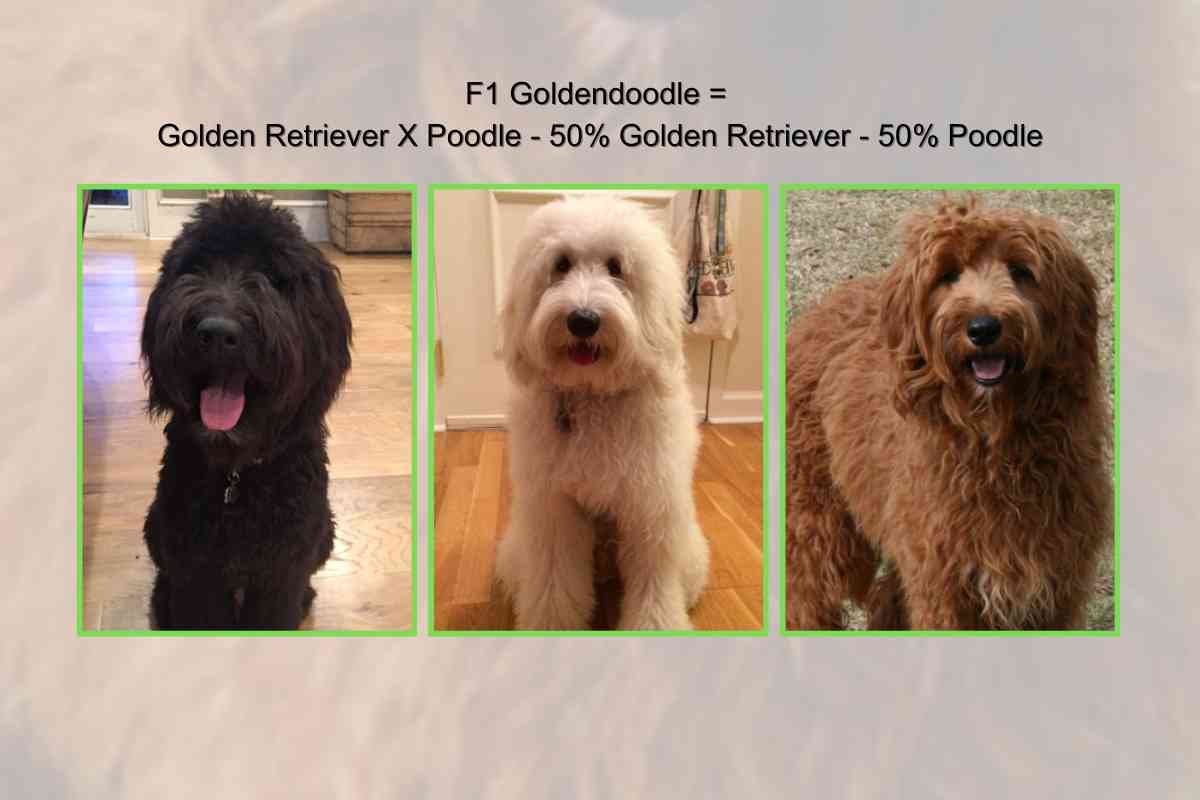
Most F1 Goldendoodles have light shedding, while some may have moderate shedding. They are suitable for families with mild allergies and have plush, straight to loose wavy coats.
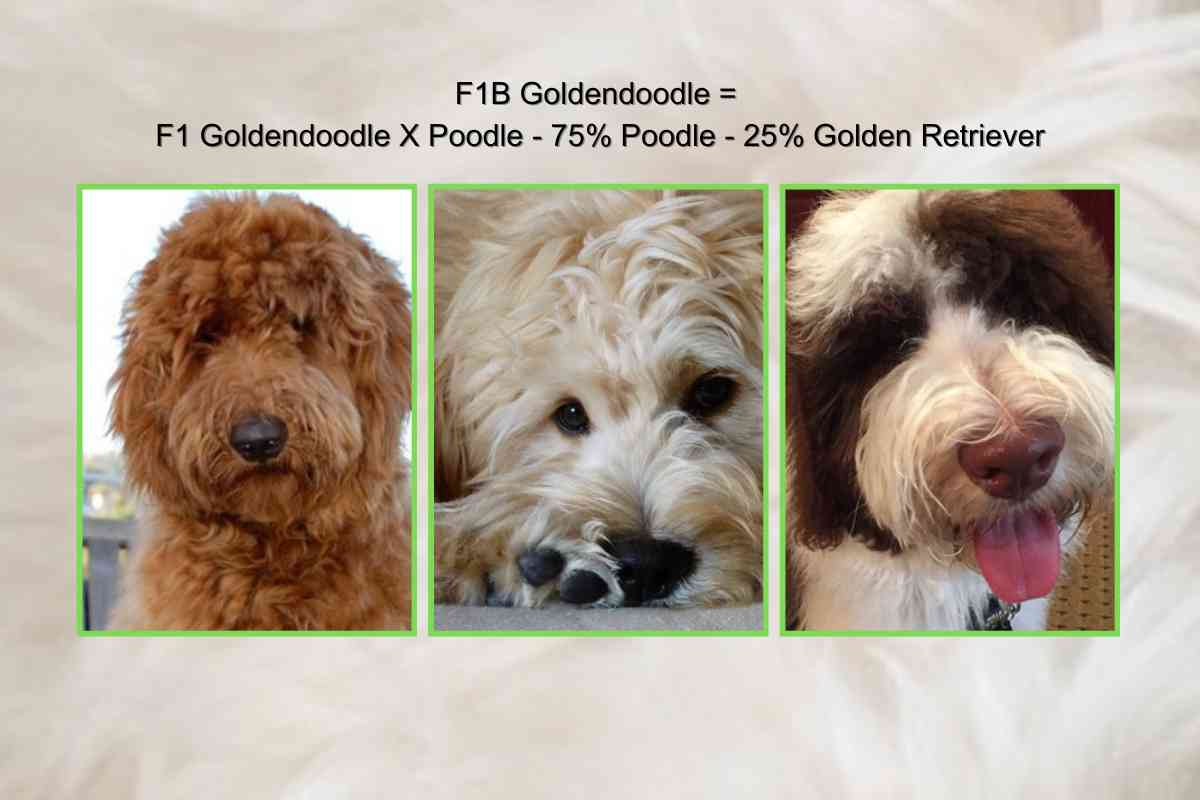
This first generation backcross is a popular choice. F1B Goldendoodles have a high chance of being non-shedding and are recommended for families with moderate to severe allergies. F1B Goldendoodles are 75% Poodle, making them among the most hypoallergenic generation. F1B Goldendoodles have plush, loose wavy to curly coats.
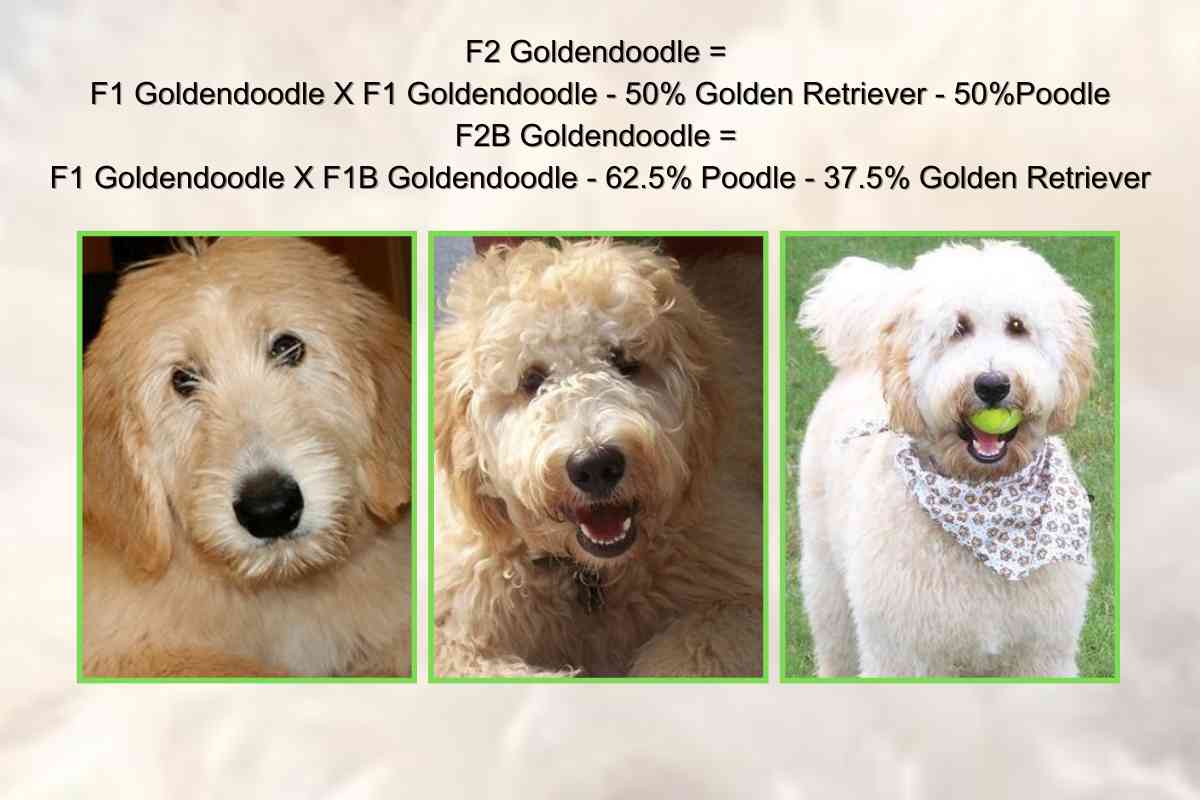
Like F1B Goldendoodles, F2 and F2B Goldendoodles have a high success rate for non-shedding, making them suitable for families with moderate to severe allergies. This second generation backcross is the last highly predictable generation of this hybrid.
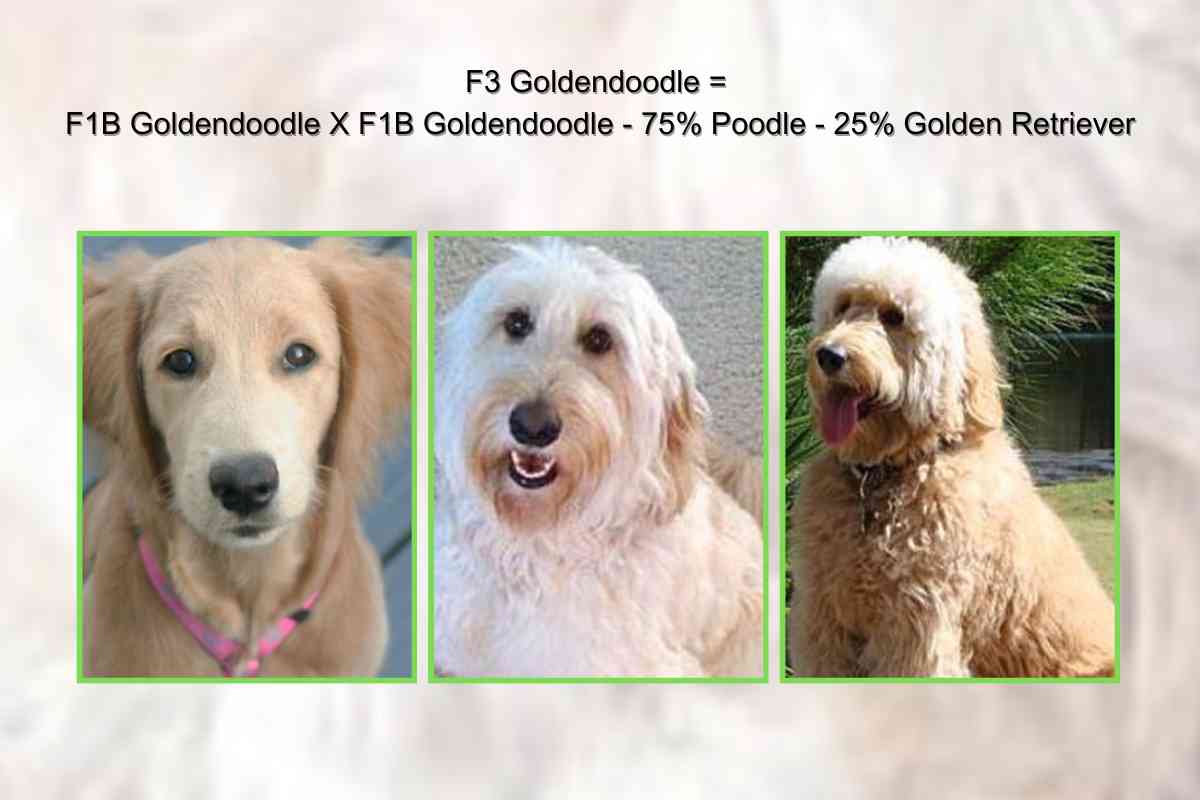
A higher number of puppies in F3 litters are prone to shedding and may have a flatter coat resembling a retriever’s coat, rather than the soft, fluffy coats that Goldendoodles are known for. Therefore, the breeding of F3 Goldendoodles is rare except in dedicated programs committed to testing and ok with a high chance of less desirable puppies.
Breeders who do strive to produce multigeneration Goldendoodles with predictable traits rely on behavior, health, and coat testing.
Shed Locus Test
The shed locus test determines how much dogs will shed. It also determines how much of their shedding characteristics they’re likely to pass on to their offspring. The test looks for different types of genes that the dog can have.
Depending on which genes the dog has, it will either shed a lot, a moderate amount, or very little. The test will tell you which genes the dog has and what that means for shedding. The test will also tell you what kind of genes the dog will pass on to its offspring.
This gives you a much better understanding whether your dog’s pedigree should be passed on, before there are puppies.
To get the coat they’re looking for, a responsible breeder will look at the shedding genetics of the stud and female dogs to reduce shedding while maintaining superb health and behavioral characteristics.
Health & Genetic Testing
You want to bring healthy pups into the world, above all else. So, make sure that your dog is free of genetic conditions they may pass on. Female breeding dogs must be healthy enough to hold up to the rigor of pregnancy, birth, and pup raising. Male dogs must be old enough that it’s clear what their weight gain and health might be.
Responsible Goldendoodle breeding starts with a health pass. Since this is a mixed-breed dog, health checking must be performed for conditions in both breeds.

What About Hybrid Vigor in Goldendoodles?
While hybrid vigor is a common advertisement for doodles, in reality, a mixed breed puppy is just as likely to get health conditions from both breeds than not getting the health conditions of either.
Two copies of the wrong gene can result in symptomatic disease, regardless of whether the breeding individuals are the same or different breeds.
In the limited research that has been done, crosses between goldens and labs resulted in dogs with better training potential but a higher prevalence of multifocal retinal dysplasia than the average prevalence in their purebred parent breeds. This makes an argument for hybrid vigor in trainability, but not health.
While the hope is that as different Goldendoodle generations are bred with careful concern to medical conditions, this breed will be healthier than either of their parents breeds, that isn’t yet the case. For now, the health benefits of genetic testing for your breeding dogs can’t be overplayed.
If you’re breeding mini or toy doodles, health concerns of mini and toy poodles are also of concern. It is crucial to test the parents of Mini and Toy Goldendoodles for patellar luxation if you plan to breed smaller dogs.
The screening should be approved by the OFA. Breeders frequently use Embark, which is OFA accepted, to test their breeding animals.
Health Conditions to Screen for in Goldendoodles
The following list isn’t complete, and it isn’t possible to test for all conditions, but these are some of the important conditions to be on the lookout for in your breeding line of doodles. The Goldendoodle Association of North America has an updated, exhaustive list of all health tests that should be done, depending on your breeding plan.
Standard Poodles and Golden Retrievers
Since these diseases are possible in both breeds that make up the Goldendoodle, extra care must be taken in screening for them.
- Hip dysplasia: This is a genetic disorder that affects the hip joints, causing them to develop abnormally. This can lead to arthritis and mobility issues. The OFA and PennHIP tests evaluate the quality of the hips and can help identify dogs at risk for hip dysplasia.
- Progressive retinal atrophy (PRA): This is a group of genetic diseases that affect the retina of the eye, leading to blindness. The OFA and CERF (Canine Eye Registration Foundation) exams can screen for PRA.
- Von Willebrand’s disease (vWD): This is a bleeding disorder caused by a deficiency in a blood clotting protein called von Willebrand factor. It can lead to excessive bleeding after injury or surgery. The vWF antigen test can identify dogs affected by or carriers of vWD.
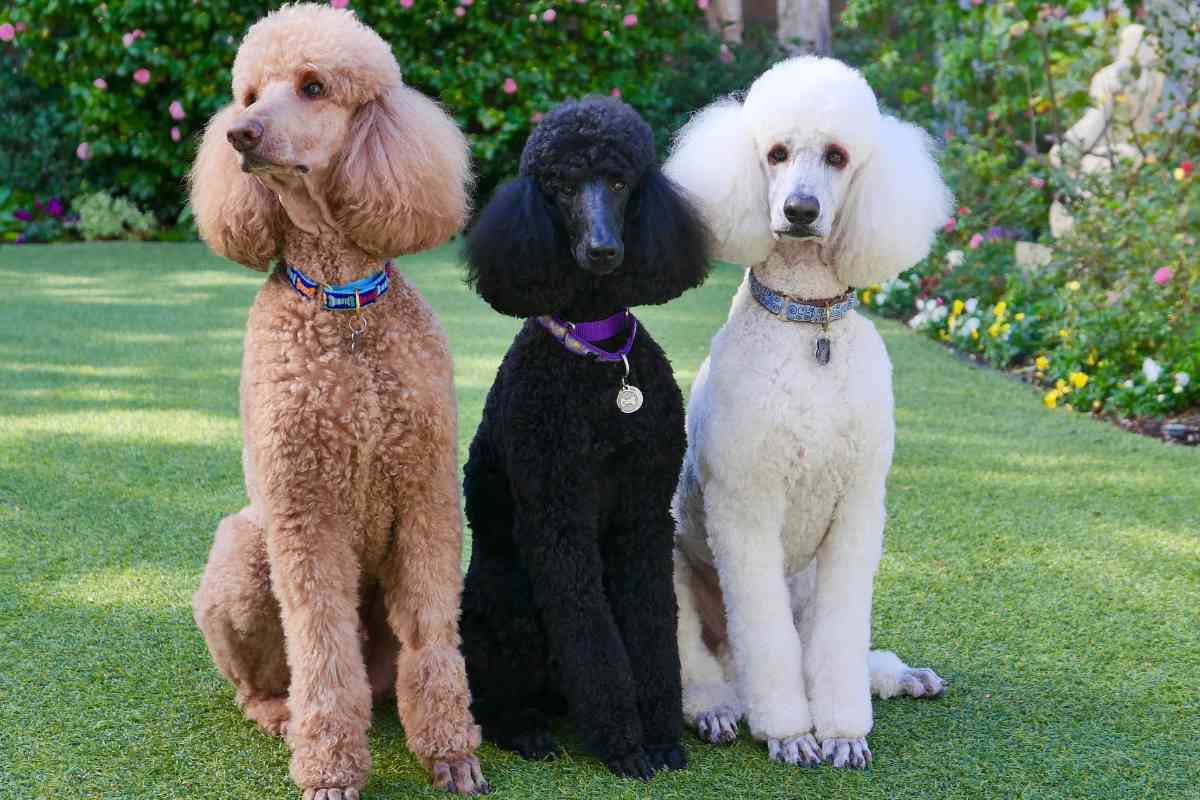
Standard Poodles
- Neonatal Encephalopathy with Seizures (NEWS): NEWS is a neurological disorder that affects newborn poodles. Testing can be done through a DNA test that detects the mutation responsible for the disease.
- Legg-Calve-Perthes Disease (LCPD): LCPD is a condition where the head of the femur (thigh bone) degenerates and can cause pain and lameness. Testing can be done through radiography (X-rays).
- Epilepsy: Epilepsy is a neurological disorder that can cause seizures. There is no specific test for epilepsy, but diagnosis is based on clinical signs and ruling out other causes of seizures.
- Addison’s Disease: Addison’s Disease is a hormonal disorder where the adrenal gland does not produce enough cortisol. Testing can be done through a blood test that measures cortisol levels.
- Sebaceous Adenitis (SA): SA is a skin disease that can cause hair loss, scaly skin, and secondary infections. Diagnosis is typically based on clinical signs and skin biopsy.
- Hypothyroidism: Hypothyroidism is a condition where the thyroid gland does not produce enough thyroid hormone. Testing can be done through a blood test that measures thyroid hormone levels.

Golden Retrievers
- Elbow dysplasia: This is a similar condition to hip dysplasia, but it affects the elbow joints. It can cause pain and lameness in affected dogs. The OFA and PennHIP tests can also screen for elbow dysplasia.
- Hereditary cataracts: This is a clouding of the lens in the eye that can cause vision problems or blindness. The OFA and CERF exams can also screen for hereditary cataracts.
- Muscular dystrophy: This is a progressive muscle-wasting disease that can affect Golden Retrievers. The condition is caused by a mutation in the DMD gene, which is inherited in an X-linked recessive manner. Genetic testing can identify carriers and affected dogs.
- Subvalvular aortic stenosis (SAS): This is a congenital heart defect that causes narrowing of the aortic valve, leading to poor blood flow and heart problems. An echocardiogram can screen for SAS.
- Osteosarcoma: This is a common type of bone cancer that can affect Goldens. It often occurs in the limbs and can cause lameness and pain. There is no genetic test for osteosarcoma, but early detection and treatment can improve outcomes.
- Degenerative myelopathy: A progressive disease of the spinal cord that affects mobility in dogs caused by a mutation in the SOD1 gene. As the disease progresses, it can lead to paralysis of the hind legs and loss of bowel and bladder control. Genetic testing can identify carriers and affected dogs.
Consider The Parents’ Personality & Temperament
You’re probably excited about dog breeding because you love your pup and want to start breeding more dogs like them. However, there are a few characteristics that all Goldendoodle breeders should strive for to ensure a high chance of a new litter full of pleasant pups.
According to the breed standard, Goldendoodles are required to have a friendly, reliable, trustworthy, and well-rounded temperament. They should be stable in most situations and environments, especially with children, elderly, and the disabled. They should be suitable to be trained as a service and therapy dog.
Temperament faults such as unwarranted hostility, timidity, nervousness, and hyperactivity should not be present in Goldendoodles. Dogs with these traits should not be bred as temperament is essential for this breed.
Here’s a summary of traits to look for and which original parents traits are most likely to come from.
- Sociability: Like Goldens, Goldendoodles should be friendly and outgoing with both people and other animals, not reserved as Poodles often are.
- Intelligence and trainability: Both Golden Retrievers and Poodles are smart, trainable breeds. Breeders should select dogs that are responsive to training and quick learners.
- Low aggression: Breeders should select dogs with a calm, non-aggressive temperament to ensure that Goldendoodles are also non-aggressive. While poodles aren’t known for being aggressive, they can have higher prey drive and tend towards nervousness.
- Playfulness: Goldendoodles should be playful and energetic, which are traits most likely in the Golden Retriever, which seems to act like a puppy throughout life.
- Affectionate: Goldens and Poodles are affectionate with their families. Breeders should select dogs that are loving and loyal (usually not hard to find in this breed).
Try Earning the Canine Good Citizen Certificate
Earning the Canine Good Citizen (CGC) certificate for your dog is a good idea before any dog breeding. It demonstrates that your dog has passed a series of tests that evaluate its behavior and temperament. These tests ensure that your dog is well-behaved, obedient, and friendly towards people and other dogs. Even though full AKC registration isn’t available to doodles, your dog is eligible for the CGC certificate.
By earning the CGC certificate, you are showing that your dog has been trained and socialized appropriately, which is essential for any breeding dog. This certificate also indicates that your dog is less likely to pass on any behavioral or temperamental issues to its offspring, ensuring that the puppies are more likely to be well-behaved and well-adjusted. It’s an easy, but powerful way to show that you are determined to breed Goldendoodles responsibly.

Ready to Breed Goldendoodles? Quick Checklist
- Ensure that the Goldendoodle is at least two to three years old before considering breeding. The female dog must be physically and mentally mature as well as sexually mature to be a good mother to the pups.
- Conduct genetic testing for health issues such as OFA testing and testing for Von Willebrand’s disease and deafness. Test for Merle genes to ensure you don’t end up breeding double merle puppies who may suffer from deafness or blindness.
- Take your Goldendoodle to a licensed veterinarian for regular check-ups and vaccinations and to ensure they are ready to have puppies. Consulting with a reproductive vet isn’t a bad idea either, especially if you’re considering breeding multigenerational doodles.
- Conduct OFA testing with x-rays or films to evaluate your dog’s hip and elbow health.
- Consider getting a Canine Good Citizen certificate to evaluate your dog’s behavior and temperament.
- Find a suitable mate for your goldendoodle, considering factors such as pedigree, weight, and genetics. if breeding for a smaller dog, the female should be larger than the male.
- Prepare for the breeding process by getting supplies like a whelping area, dog food, disposable gloves, formula in case you need to assist in bottle feeding puppies, etc.
Raising Goldendoodle Puppies
When raising Goldendoodles, it is important to start their socialization and training at an early age with young puppies. This helps to shape their emotional and mental well-being and prevent future behavioral problems. This naturally friendly breed still needs enough time to socialize and experience new things to prepare for new families.
Training and socialization mentally stimulates and familiarizes puppies with human interaction, grooming, and body handling. Teaching Goldendoodles to accept grooming from an early age is critical, since it will be a big part of their lives.
Crate training, potty training, and obedience training are also essential to improve their confidence and make their transition smoother when going to their forever homes. The Early Neurological Stimulation (ENS) method is recommended for improving puppies’ overall health and stress resistance.
An animal behaviorist can recommend a system to help you raise the best puppies possible.
Finding Homes for Goldendoodle Puppies
Advertise your puppies on a quality puppy advertising site, social media, and local pet groups as soon as you know your dog is pregnant or even during the first heat cycle in which you intend to breed. You want your litter of puppies to have homes well before they’re eight weeks old.
Advertise that your puppies have been cleared of health issues and that these Goldendoodles are registered with the Goldendoodle Association and any other relevant organizations.
Make it clear that the orthopedic foundation has cleared your breeding stock from hip and elbow dysplasia and that if the merle gene is in your puppies, there is no increased risk of a double merle because of your careful breeding choices.
Charge an appropriate fee for your puppies to cover labor and other expenses. Charge enough that you can be confident you’ll attract committed families ready to take on a puppy. Make it clear that you want the puppy back if they ever decide they can’t keep it.
Is Breeding Goldendoodles a Good Idea?
While doodles aren’t recognized as an official breed by the American Kennel Club, they are being bred by very legitimate organizations, such as the Guide Dogs of America.
They have expanded their breed options to include Standard Poodles and strategic cross-breeds to increase the options in available guide dogs. Cross-breeds such as Goldendoodles and Goldadors are being trained alongside purebred dogs.
The goal of this breeding and training program is to address concerns about allergies, as poodles and poodle crosses produce less dander. Other cross-breeds aim to combine the best traits of two breeds, such as the responsiveness of a Golden Retriever and the confidence of a Labrador. The breeding program for Standard Poodles is still in its early stages.
GDA is using donated puppies from experienced dog breeders to find the perfect match between guide dog and person without sight.
Needless to say, Goldendoodle breeding to help the blind is a legitimate cause.

What about breeding two Goldendoodle of higher generations like F3 and F4?
Goldendoodles from higher generations, including F3 and F4, and their variations are known as multi-generational. These dogs take on more variations and potential for unpredictable patterns emotionally, physically, and mentally unless breeding stock is carefully tested and planned.
F3 Goldendoodles are further removed from their purebred ancestors, which means they have a higher likelihood of inheriting genetic traits and health conditions that can be unpredictable. This is why it is important for breeders to conduct more testing for coat and health conditions when breeding F3 Goldendoodles.
F3 Goldendoodles may also have a higher risk of developing certain health conditions or behavior issues due to the complex nature of their breeding. Breeders should work with licensed veterinarians and reproductive specialists to ensure that they are conducting the appropriate tests and screenings to prevent any potential health or behavior issues.
Breeding past F3 doodles means that breeders are working to make a brand new breed, as opposed to a hybrid of two breeds. These dogs may be a great fit as therapy dogs, service dogs, and pets, but it will take a lot of work and many generations to get there.
F3 Goldendoodles require more testing for coat and health conditions to ensure that the puppies are healthy and have the desired traits, but in the future, these may be the most predictable dogs in terms of health, behavior, and coat.
Final Thoughts
Breeding healthy, happy Goldendoodle puppies can be extremely fulfilling, whether you want to breed your own pet or start a serious breeding endeavor. Just remember how important it is to rule out any health problems the parents carry and keep shedding levels down.
Related Content You May Find Interesting
Here are some more articles that may be of interest to you if you’re curious about Goldendoodle breeding.
- Goldendoodle breeding can be complex due to the different generations and coat types.
- Breeding two Goldendoodles together is possible, but it becomes harder to get predictable traits in coat type, behavior, and health beyond F3.
- Guide Dogs of America breed and train Goldendoodles and other cross-breeds to address concerns about allergies and combine the best traits of two breeds.
- F1 Goldendoodles are a mix of a Golden Retriever and a Poodle, and the F number indicates the generation.
- F1B, F2, and F2B Goldendoodles have a higher chance of being non-shedding and are recommended for families with moderate to severe allergies.
- F3 Goldendoodles have a higher tendency to shed, and breeding them is rare.
- Coat testing, specifically the shed locus test, is used by responsible breeders to reduce shedding while maintaining good health and behavior.
- Breeding healthy pups is the main priority.
- Responsible Goldendoodle breeding involves health checks for both breeds involved.
- Hybrid vigor in Goldendoodles is not guaranteed and mixed breed puppies can inherit health conditions from both parent breeds.
- Breeding programs must screen for genetic diseases approved by the OFA, and Embark is a common testing
tool . - There is a list of health conditions to screen for in both standard poodles and golden retrievers before breeding, including hip dysplasia, PRA, vWD, LCPD, and more.
- Personality and temperament of the breeding doodles should also be taken into consideration.


